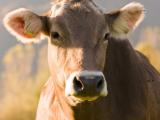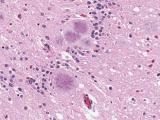Mar 11, 2004 (CIDRAP News) – The US Department of Agriculture (USDA) is inviting another round of comments on a proposal to allow imports of live Canadian cattle, which were halted when a case of bovine spongiform encephalopathy (BSE) was found in Alberta last May.
The USDA first announced the proposal in November to allow imports of live cattle from countries that have had isolated BSE cases and took comments for 2 months. In a Mar 4 announcement, the agency said it had decided to invite more comments in the wake of the discovery of the first US case of BSE in Washington State in December. Comments will be accepted until Apr 7.
Current USDA rules on beef imports from Canada and other countries considered at "minimal risk" for BSE allow the importation of boneless meat from cattle 30 months or younger and veal from calves under 36 weeks old, according to Susan Holl of the USDA's Animal and Plant Health Inspection Service (APHIS). Meat from a few other types of ruminant animals, such as deer and elk, is also permitted, Holl told CIDRAP News.
Plan would admit young cattle
As announced in November, the USDA proposal was to allow importing of live cattle under 30 months of age and destined for immediate slaughter. BSE, or mad cow disease, has very rarely been found in cattle younger than 30 months.
The USDA said it is now proposing to also permit importation of beef from cattle older than 30 months, but excluding high-risk tissues such as the skull, brain, eyes, vertebral column, and spinal cord. The USDA banned the use of these "specified risk materials" (SRM) in human food after the Washington BSE case was found.
In a Mar 8 Federal Register notice, the USDA said, "We now believe it would not be necessary to require that beef imported from BSE minimal-risk regions be derived only from cattle less than 30 months of age, provided equivalent measures are in place to ensure that SRMs are removed when the animals are slaughtered, and that such other measures as are necessary are in place. We believe such measures are already being taken in Canada."
In response to the Washington BSE case, the USDA also banned the use of disabled, or "downer," cattle, for food. The agency said Canada has adopted a similar measure.
The BSE-infected cow in Washington had been imported from Canada and was 6 years and 8 months old when it was slaughtered. It was born before Canada banned the feeding of cattle parts to cattle, which can spread BSE, the Federal Register article notes.
Mexico resumes importing some American beef
In other recent BSE-related developments, Mexico agreed last week to a partial reopening of its borders to American beef, banned since the BSE case turned up in Washington. The National Cattlemen's Beef Association (NCBA) said Mexican officials agreed to allow the importing of boneless beef from cattle less than 30 months old.
Mexico is the second largest buyer of American beef, and boneless meat from young cattle makes up most of the beef it imports, the NCBA said.
In related news last week, USDA Inspector General Phyllis K. Fong told Congress that the government has begun a criminal investigation of whether documents were falsified in connection with the BSE case in Washington. According to a Mar 4 New York Times report, Fong told a House appropriations subcommittee that the inquiry was focusing on whether the infected cow was a downer when it was slaughtered Dec 9.
Fong said the probe was based on allegations reported in the news media in early February about possible alteration of records, according to the Times account. She did not identify who the investigation would focus on.
A USDA veterinarian at the Moses Lake, Wash., slaughter plant found the cow lying down when he examined it at the plant, according to USDA statements. But three witnesses, including the plant worker who killed the cow, have publicly said the cow was walking. The USDA's BSE testing program has focused chiefly on downer cattle because they are considered most likely to have BSE, and a finding of BSE in a healthy-looking cow would appear to signal the need for a broader testing program.
Thomas Ellestad, co-manager of the slaughter plant, told a House committee last month that the infected cow was tested not because it was a downer but because the plant had a contract with the USDA to supply cattle brain samples for testing, regardless of the cattle's condition. The USDA announced in late February that its inspector general would investigate the case.















